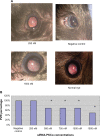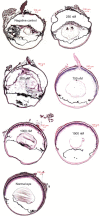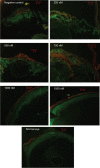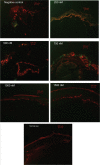The inhibitory effect of small interference RNA protein kinase C-alpha on the experimental proliferative vitreoretinopathy induced by dispase in mice
- PMID: 23626468
- PMCID: PMC3632628
- DOI: 10.2147/IJN.S37635
The inhibitory effect of small interference RNA protein kinase C-alpha on the experimental proliferative vitreoretinopathy induced by dispase in mice
Abstract
Aim: To evaluate the effects of small interference RNA protein kinase C-alpha (siRNA-PKCα) on experimental proliferative vitreoretinopathy (PVR) induced by dispase in mice.
Methods: C57BL/6 mice PVR models (4-6 weeks old) were induced by intravitreal injection of dispase and then equally divided into six groups. After 1 week, the five treatment groups received 2 μL, intravitreal injections of siRNA-PKCα at a concentration of 250 nM, 500 nM, 750 nM, 1000 nM, and 1500 nM, respectively, while the negative control group received 2 μL of 500 nM no-silencing siRNA. SiRNA-PKCα was transfected by a square wave electroporator. Postoperative ophthalmic observations of lens clarity and the fundus of the eyes were performed periodically. The eyeballs of the mice were enucleated and imbedded in optimal cutting temperature to perform histological and immunofluorescence analysis at the end of a 4-week observation period.
Results: Four weeks after the siRNA-PKCα injections, there are 100% lens dissolution and 100% PVR in the 250 nM group and 70%, 70%, 70%, and 50% PVR in the 500 nM, 750 nM, 1000 nM, and 1500 nM groups, respectively, which is significantly different from the negative group. Abnormalities in fundus appearance were related to the concentrations of siRNA-PKCα; a higher concentration of siRNA-PKCα resulted in a more normal fundus. Histological sections by hematoxylin-eosin staining of the eyes support the clinical observation. Immunofluorescence analysis showed that RPE65, glutamine synthase, glial acidic fibrillary protein, and α-smooth muscle actin were increasing in the retina with the decreasing concentration of siRNA-PKCα, indicating that intraocular siRNA-PKCα can partly inhibit changes of markers for glia cells, fibroblast cells, retinal pigment epithelium cells, and Müller cells in the process of PVR.
Conclusion: Gene therapy with siRNA-PKCα could effectively inhibit PVR in mice and provide us with a novel therapeutic target on PVR.
Keywords: dispase; proliferative vitreoretinopathy; protein kinase Cα; small interference RNA.
Figures







Similar articles
-
Protein kinase Cα downregulation via siRNA-PKCα released from foldable capsular vitreous body in cultured human retinal pigment epithelium cells.Int J Nanomedicine. 2011;6:1303-11. doi: 10.2147/IJN.S19405. Epub 2011 Jun 22. Int J Nanomedicine. 2011. PMID: 21753881 Free PMC article.
-
A new model of proliferative vitreoretinopathy.Invest Ophthalmol Vis Sci. 1998 Oct;39(11):2157-64. Invest Ophthalmol Vis Sci. 1998. PMID: 9761295
-
Ocular pathogenesis and immune reaction after intravitreal dispase injection in mice.Mol Vis. 2012;18:887-900. Epub 2012 Apr 7. Mol Vis. 2012. PMID: 22511850 Free PMC article.
-
Periostin in vitreoretinal diseases.Cell Mol Life Sci. 2017 Dec;74(23):4329-4337. doi: 10.1007/s00018-017-2651-5. Epub 2017 Sep 14. Cell Mol Life Sci. 2017. PMID: 28913545 Free PMC article. Review.
-
Proliferative vitreoretinopathy: A new concept of disease pathogenesis and practical consequences.Prog Retin Eye Res. 2016 Mar;51:125-55. doi: 10.1016/j.preteyeres.2015.07.005. Epub 2015 Jul 21. Prog Retin Eye Res. 2016. PMID: 26209346 Review.
Cited by
-
Mechanisms of Epithelial-Mesenchymal Transition and Prevention of Dispase-Induced PVR by Delivery of an Antioxidant αB Crystallin Peptide.Antioxidants (Basel). 2022 Oct 21;11(10):2080. doi: 10.3390/antiox11102080. Antioxidants (Basel). 2022. PMID: 36290802 Free PMC article.
-
Small Molecular-Sized Artesunate Attenuates Ocular Neovascularization via VEGFR2, PKCα, and PDGFR Targets.Sci Rep. 2016 Aug 2;6:30843. doi: 10.1038/srep30843. Sci Rep. 2016. PMID: 27480521 Free PMC article.
-
In vitro vitamin K3 effect on conjunctival fibroblast migration and proliferation.ScientificWorldJournal. 2014 Jan 8;2014:916713. doi: 10.1155/2014/916713. eCollection 2014. ScientificWorldJournal. 2014. PMID: 24523654 Free PMC article.
-
A Mouse Model of Proliferative Vitreoretinopathy Induced by Intravitreal Injection of Gas and RPE Cells.Transl Vis Sci Technol. 2020 Jun 5;9(7):9. doi: 10.1167/tvst.9.7.9. eCollection 2020 Jun. Transl Vis Sci Technol. 2020. PMID: 32832216 Free PMC article.
-
Experimental Models to Study Epithelial-Mesenchymal Transition in Proliferative Vitreoretinopathy.Int J Mol Sci. 2023 Feb 24;24(5):4509. doi: 10.3390/ijms24054509. Int J Mol Sci. 2023. PMID: 36901938 Free PMC article. Review.
References
-
- Grigoropoulos VG, Benson S, Bunce C, Charteris DG. Functional outcome and prognostic factors in 304 eyes managed by retinectomy. Graefes Arch Clin Exp Ophthalmol. 2007;245(5):641–649. - PubMed
-
- Quiram PA, Gonzales CR, Hu W, et al. Outcomes of vitrectomy with inferior retinectomy in patients with recurrent rhegmatogenous retinal detachments and proliferative vitreoretinopathy. Ophthalmology. 2006;113(11):2041–2047. - PubMed
-
- Pastor JC, de la Rúa ER, Martin F. Proliferative vitreoretinopathy: risk factors and pathobiology. Prog Retin Eye Res. 2002;21(1):127–144. - PubMed
-
- Ryan SJ. The pathophysiology of proliferative vitreoretinopathy in its management. Am J Ophthalmol. 1985;100(1):188–193. - PubMed
-
- Agrawal RN, He S, Spee C, Cui JZ, Ryan SJ, Hinton DR. In vivo models of proliferative vitreoretinopathy. Nat Protoc. 2007;2(1):67–77. - PubMed
Publication types
MeSH terms
Substances
LinkOut - more resources
Full Text Sources
Other Literature Sources
Research Materials

